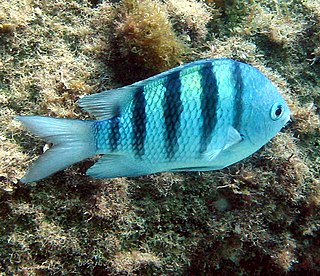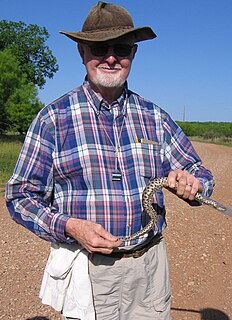
Phyllodactylus is a genus of geckos distributed in South America and Central America, and as far north as the southern United States. They are commonly known as "leaf-toed geckos" in their native range, and otherwise as American leaf-toed geckos to distinguish them from unrelated genera with similar feet.

The common rock thrush, also known as rufous-tailed rock thrush or simply rock thrush, is a chat belonging to the family Muscicapidae. It was formerly placed in the family Turdidae. The scientific name is from Latin. Monticola is from mons, montis "mountain", and colere, "to dwell", and saxatilis means "rock-frequenting", from saxum, "stone".
The western leaf-toed gecko is a species of gecko. It is endemic to Peru. It was described by Johann Jakob von Tschudi in 1845.

The narrow leaf-toed gecko is a medium-sized gecko with a maximum snout-vent length of 57 mm.

The sergeant major or píntano is a species of damselfish. It grows to a maximum length of about 22.9 centimetres (9.0 in).

Littorina is a genus of small sea snails, marine gastropod molluscs in the family Littorinidae, the winkles or periwinkles.

Phyllodactylus xanti is a species of lizard in the family Phyllodactylidae. It is endemic to northwestern Mexico. It is also known as the leaf-toed gecko or Raza Island leaf-toed gecko when referring to the subspecies from the Raza Island; at present, there are altogether four recognized subspecies, while several more have been recognized previously.

James Ray Dixon was professor emeritus and curator emeritus of amphibians and reptiles at the Texas Cooperative Wildlife Collection at Texas A&M University. He lived in El Campo, Texas throughout most of his childhood. He published prolifically on the subject of herpetology in his distinguished career, authoring and co-authoring several books, book chapters, and numerous peer reviewed notes and articles, describing two new genera, and many new species, earning him a reputation as one of the most prominent herpetologists of his generation. His main research focus was morphology based systematics of amphibians and reptiles worldwide with emphasis on Texas, US, Mexico, Central America, and South America, although bibliographies, conservation, ecology, life history and zoogeography have all been the subjects of his extensive publications.

Rubus saxatilis, or stone bramble, is a species of bramble widespread across Europe and Asia from Iceland and Spain east as far as China. It has also been found in Greenland.
The Lima leaf-toed gecko has been registered in six archeological sites in Lima, Peru, where it is endemic. It is considered a species in critical danger.

The scrub hare is one of two subspecies of hares found in southern Namibia, Mozambique, South Africa, Swaziland and Lesotho. Although it is listed as a least concern species, the population has been declining and is expected to decline by 20% over the next 100 years.

Littorina saxatilis, common name the rough periwinkle, is a species of small sea snail, a marine gastropod mollusc in the family Littorinidae, the winkles or periwinkles. First identified in the 1700s, it has been misidentified as a new species 112 times.

The peninsula leaf-toed gecko is a medium-sized gecko. It is found in southern California (USA) and Baja California (Mexico), including many islands in Gulf of California as well as Islas Magdalena and Santa Margarita off the west coast of Baja California.

Mimetes saxatilis or limestone pagoda is an evergreen, upright, rarely branching shrub of 1–2¼ m high, assigned to the family Proteaceae. The approximately oval leaves are 3½–5 cm (1.4–2.0 in) long and 1½–3 cm (0.6–1.2 in) wide with a blunt, thickened, reddish tip or with three crowded teeth. It has cylinder-shaped inflorescences topped by a crest of green leaves, further consisting of heads with 12-22 individual bright yellow flowers, each in the axil of a flat, green leaf. It is an endemic species that is restricted to limestone outcrops in the Agulhas plains in the very south of the Western Cape province of South Africa. It is considered an endangered species. Flowering may occur between July and December, but is unreliable in its timing, dependent on sufficient moisture availability.
Phyllodactylus ventralis, the Margarita leaf-toed gecko, is a species of lizard found in northern Colombia, Venezuela, and according to some sources, also Grenada and other Windward Islands.
The Barrington leaf-toed gecko is a species of lizard in the family Phyllodactylidae. The species is endemic to Santa Fe Island in the Galapagos.
Baur's leaf-toed gecko is a species of lizard in the family Phyllodactylidae. The species is endemic to the Galápagos Islands.
The Catalina Island leaf-toed gecko is a species of gecko. It is endemic to Isla Santa Catalina in Gulf of California, Mexico.
The Pardita Norte leaf-toed gecko is a species of gecko. It is endemic to Isla Partida in Mexico.
The Rio Marquez Valley gecko is a species of gecko. It is endemic to Mexico.










